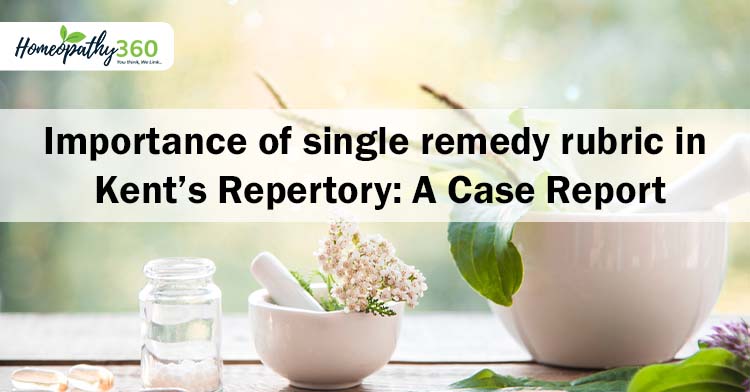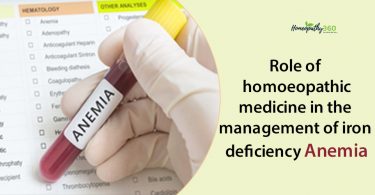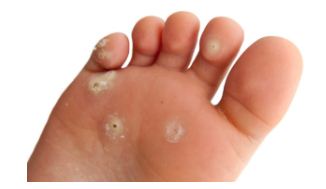
INTRODUCTION
Single remedy rubrics in Homeopathic Repertory are important because they help in identifying the specific symptoms that can be treated with a particular Homeopathic remedy. These rubrics list the symptoms that are unique to a single remedy, as opposed to common symptoms that many remedies share.
The use of single remedy rubrics can help narrow the choices of remedies when trying to match a patient’s symptoms to a remedy. By identification of the exact symptoms associated with a particular remedy, the prescription can be made more accurate thereby increasing the likelihood of a successful outcome.
We often come across rubrics with single remedy in Kent’s Repertory.
Below is a case report of impetigo, successfully treated by referring to a single remedy rubric.
CASE HISTORY
Three-year-old male presented to the OPDon November 18, 2021withcomplaints of red sores on the facefor a duration of 4 weeks with blisterswhich were ooze and spread to the surrounding areas on face.

History of the patient was provided by the child’s mother. The sore started near the nose, which then turned into a blister, that oozed pus. It then spread to the rest of the face and had a yellow golden crust. Patient complained of itching on the sores, it became painful after scratching.Patient was given oral and topical antibiotics for one week. He then felt better, but soon the sores came back, and were much aggravated than the last time.
There was no significant pastmedical or family history of any disease.
Mother’s obstetric history– first pregnancy, full term, vaginal delivery
Developmental landmarks – on time so far
Physical Generals –
- Thermal Reaction: Hot
- Appetite and Thirst: Good
- Bowel Habit: Passes stool twice daily
- Bladder: No associated complaints; passes urine four to five times daily
- Desire: Sweets
- Sleep: 8-9 hours, Refreshing
- Perspiration: Generalized
DIAGNOSIS
Impetigo1is acommon skin disease in pre-pubertal age. It is a contagious superficial skin infection commonly caused by Staphylococcus aureus and in some cases, haemolytic Streptococcus. The disorder is characterized by red sore areas on exposed skin surfaces that may blister. Itching and pain accompanies the sore. Yellow golden crust surmounts the lesions which appear and spread within a few days. This condition may persist for longer unless treated adequately.
This condition is clinically diagnosed.
ICD code – L 01
CASE ANALYSIS
Since the only peculiarity about the case was the particular symptom of skin complaint, Kent’s Repertory2 was referred for the same. The rubric found for the same is given below.

Single remedy rubrics are considered important for prescription. Reference of Boericke’s Materia Medica3confirmed the symptom. Hence, Antimonium tart 30 was prescribed, twice a day for 1 week.
FOLLOW-UP
29 Nov 2021: The patient presented with a drastic improvement within a span of 10 days. No signs of itching or pain.The picture of the same is attached below. Since the patientgot better, placebo was prescribed for oneweek.

06 Dec 2021: The patient’s lesions had almost disappeared. No associated itching, pain or discomfort.The picture of the same is attached below.Therefore, placebo was continued for another week.
CONCLUSION
This is a case wherea single remedy rubric,rightly fits the picture of the patient. Surprisingly, when we refer the rubric Skin- Eruptions- impetigo in Kent’s Repertory, the remedy Antimonium tart is not mentioned.
With this case, I came to the conclusion that single remedy rubrics are very important for prescription as they help in individualising a case. The peculiar, queer, rare and specific (PQRS) symptoms are represented as rubrics with single remedies in the repertories. It can be utilized to bring forth marvellous results and to increase the knowledge of Materia Medica as well.
REFERENCES
1. R. Marks, Roxburgh’s common skin diseases, 16th edition. London: Chapman & Hall; 1993
2. Kent JT, Repertory of Homoeopathic Materia-Medica, 3rd ed. Kolkata: Rup publication; 2016
3. Boericke W. Boericke’s New Manual of Homoeopathic Materia Medica with Repertory, Third revised and Augmented Edition. New Delhi, India: B. Jain Publishers; 2007





